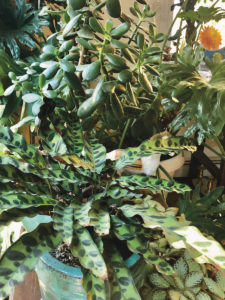
Frost etches the margins of the grass in the early morning. You can see your breath when you step outside at night. The bin of winter clothing has been pulled from beneath the bed and all the warm blankets are out of their summer hiding place. You have brought your house plants back inside. They have come to their favorite window or their bright, warm corner to live while the snow falls outside.
Caring for house plants is rewarding. Few things are more enjoyable than seeing the glossy, tender new leaf of a monstera unfurl over the course of a few days. Or finally succeeding in getting a jade plant to produce its little galaxy clusters of white flowers. House plants are living sculptures that we bring into our homes. Their foliage spills from window sills and fills bookshelves with texture and movement. They demand our care and attention and reward us when we listen properly.
All that exotic, colorful foliage has a native home somewhere. I visited Colombia a few years back and was amazed to see philodendron and monstera climbing 50 feet into the canopies of trees and consuming entire buildings. I felt renewed inspiration to do a better job taking care of mine.
Our house plants are completely dependent on us for their survival. If we listen well, we can even make them thrive. The plants in our homes are always sharing information about how they are doing. It is told in the way they look, how enthusiastically they grow, in their color, their vibrancy. It’s a symbiotic relationship in the end: the more you give to your plants, the more they will give back to you their subtle but enlightening presence.
Each plant is different, and each has a unique set of requirements. But the basics are simple: soil, water, light, nutrients, love.

A well-drained soil mix tends to be best for most plants. It helps avoid soggy roots and allows for good water infiltration. Repotting into larger pots every few years will do wonders. If space is an issue, repotting into the same pot is OK if you cut back the roots, shake off the old, depleted soil, and replace it with a new mix.
Water seems to be the big question for most people. A good rule is to let the soil dry out between waterings, but not to the point where the soil pulls away from the pot’s edges. Evenly moist is a good place for your soil to be. Make sure there are drain holes in the pot. Stagnant water is the enemy of roots.
Bottom watering is great for plants. Place them in a large tub and let the soil draw the water in for an hour. This will provide good saturation and keep the soil from becoming hydrophobic. Let them drain out in the sink or bathtub, bring them back to their spot when they’ve finished, and watch them perk up.



